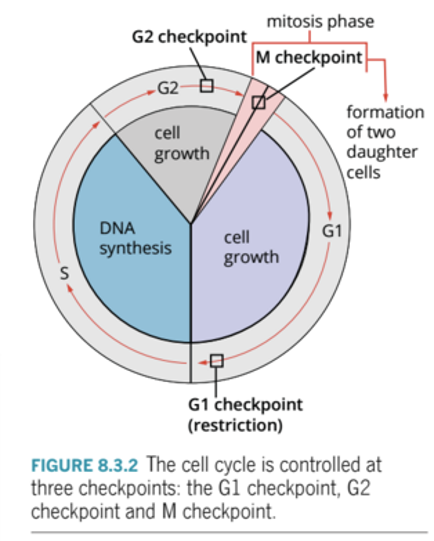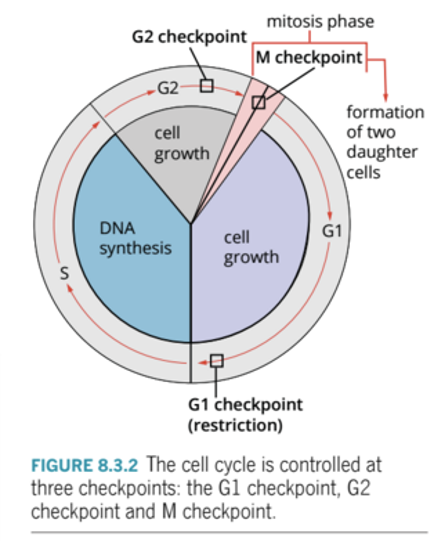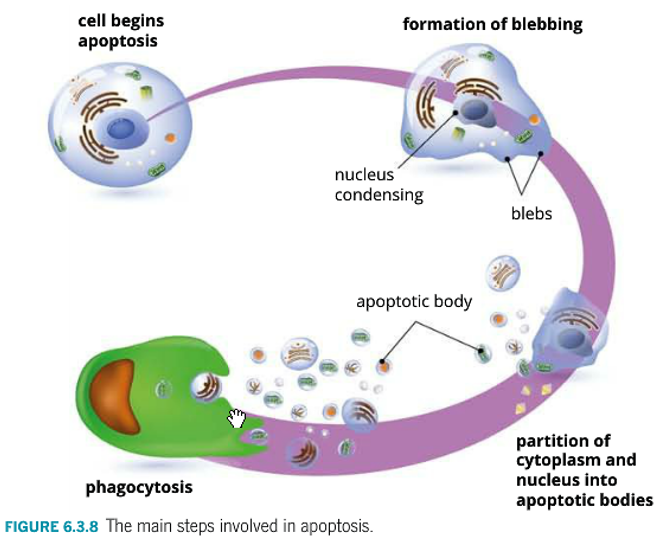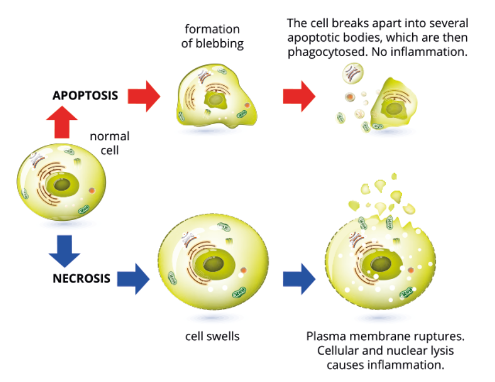Controlling the Cell Cycle
5.0(1)
Card Sorting
1/32
Study Analytics
Name | Mastery | Learn | Test | Matching | Spaced |
|---|
No study sessions yet.
33 Terms
1
New cards
What is the cell control system?
A group of proteins that regulate the cell cycle.
2
New cards
How does the cell internally regulate itself?
By using three checkpoints, G1, G2, M.
3
New cards
What happens if the conditions of the checkpoints are not met?
The cell will not enter the next phase of the cell cycle.
4
New cards
G1 Checkpoint (restriction)
End of G1
* Are there adequate resources (nucleotides) for division? Is the cell large enough? Has the DNA been damaged?
* Are there adequate resources (nucleotides) for division? Is the cell large enough? Has the DNA been damaged?

5
New cards
G2 Checkpoint
End of G2
* Are there adequate resources (mitotic proteins) for division? Is the cell large enough? Has the DNA been damaged?
* Are there adequate resources (mitotic proteins) for division? Is the cell large enough? Has the DNA been damaged?

6
New cards
M Checkpoint
End of Metaphase
* Have the spindle fibres attached correctly to the chromatids? Are the chromosomes aligned correctly?
* Have the spindle fibres attached correctly to the chromatids? Are the chromosomes aligned correctly?

7
New cards
External Cell Cycle Controls
* Molecular signals: contact with other cells, tumours release signalling molecules, hormones promote cell division in tissue.
* Environmental conditions: pH levels, temperature, nutrients.
* Environmental conditions: pH levels, temperature, nutrients.
8
New cards
What happens if uncontrolled cell division occurs in a mature organism?
A neoplasm may form.
9
New cards
What is a neoplasm?
An abnormal growth of tissue that can form a mass, for example a tumour. They can eventually become cancer.
10
New cards
What exactly is cancer?
Unregulated and abnormal cell division. It is commonly caused by the increased rate of cell division or the suppression of apoptosis.
11
New cards
Benign Neoplasm
Form localised masses but do not transform into cancer.
12
New cards
Potentially Malignant Neoplasm
Form localised masses that **will eventually** invade other tissues and transform into cancer.
13
New cards
Malignant Neoplasms
Form masses that invade other tissues and transform into cancer.
14
New cards
How are cancer cells different from normal cells?
* Faster division
* Less specialised
* Develop their own blood supply
* DNA mutations occur
* No limited number of divisions
* Can spread to other parts of the body.
* Less specialised
* Develop their own blood supply
* DNA mutations occur
* No limited number of divisions
* Can spread to other parts of the body.

15
New cards
What are proto-oncogenes?
They control the stimulation of cell growth and are required for normal growth and development.
16
New cards
Causes of Cancer: Genetic Factors
* Mutations to proto-oncogenes: mutation turns them to oncogenes that promote uncontrolled cell division
* Mutations to tumour suppressor genes
* Hereditary cancers: when someone inherits mutated genes.
* Mutations to tumour suppressor genes
* Hereditary cancers: when someone inherits mutated genes.
17
New cards
Mutagens
Environmental factors that can damage DNA.
18
New cards
Carcinogens
Cancer causing agents.
19
New cards
Causes of Cancer: Environmental Factors
* Chemical: tobacco, air pollution
* Physical: X-Rays, UV light
* Biological: Viruses
* Physical: X-Rays, UV light
* Biological: Viruses
20
New cards
Apoptosis
Programmed cell death, highly coordinated process that does not spill cell contents or trigger an immune response.
21
New cards
Why does Apoptosis occur?
* Cells which are damaged or defective must be eliminated.
* During fetal development, the removal of excess cells.
* During fetal development, the removal of excess cells.
22
New cards
What are Caspases?
Apoptotic Enzymes
23
New cards
What is Phagocytosis?
The breakdown of apoptotic bodies by the phagocytes.
24
New cards
Major Steps of Apoptosis
1. Activation of caspases and begin breakdown of cell contents.
2. Cell shrinks and blebs begin to form.
3. Cells continue to shrink and package themselves into apoptotic bodies.
4. Phagocytosis.

25
New cards
Necrosis
Accidental and uncontrolled cell death, can cause inflammation and damage to surrounding cells.
26
New cards
Why does the cell explode during Necrosis?
The plasma membrane is damaged and ruptures, therefore the cell explodes and contents are released.
27
New cards
What causes Necrosis?
Caused by physical damage, toxins, pathogens, lack of oxygen.
28
New cards
Apoptosis vs Necrosis
* In necrosis, external factors cause internal tissue damage and cell disfunction.
* Apoptosis is pre-planned, and required for smooth bodily functioning..
* Necrosis is cellular death when exposed to extreme conditions.
* Apoptosis is pre-planned, and required for smooth bodily functioning..
* Necrosis is cellular death when exposed to extreme conditions.

29
New cards
Apoptotic Pathways
* Mitochondrial Pathway (Intracellular): Triggered when cell components, DNA, is damaged. Proteins signal for beginning of cascade reactions.
* Death Receptor Pathway (Extracellular): Triggered by immune cells outside the target cell. Cells under stress can all trigger this pathway.
* Death Receptor Pathway (Extracellular): Triggered by immune cells outside the target cell. Cells under stress can all trigger this pathway.
30
New cards
Malfunctions in Apoptosis
* Too much apoptosis can lead to degenerative diseases such as Alzheimer’s or Parkinson’s.
* Too little apoptosis is seen in Syndactyly, where the skin between digits is not removed during embryonic development.
* Too little apoptosis is seen in Syndactyly, where the skin between digits is not removed during embryonic development.
31
New cards
How can Apoptosis cause Cancer?
Due to apoptosis not occurring when it should:
* Genetic mutations that increase cell division rate.
* Caspases mutations that prevent function.
* Defects in proteins leading to caspases activation
* Defects in signal reception of apoptosis triggers.
* Genetic mutations that increase cell division rate.
* Caspases mutations that prevent function.
* Defects in proteins leading to caspases activation
* Defects in signal reception of apoptosis triggers.
32
New cards
Cascade
Series of caspases reactions.
33
New cards